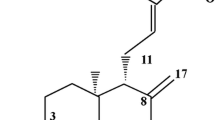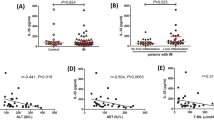Abstract
To identify a candidate compound for therapy of chronic viral hepatitis, we screened a series of oleanene-type triterpenoids for their ability to alleviate aflatoxin B1 (AFB)-induced cytotoxicity, protect against actinomycin-tumor necrosis factor-induced apoptosis, and modulate the mixed lymphocyte reaction (MLR) in cultured cells. Glycyrrhizin at 200 μg/ml showed the strongest inhibitory effects on cytotoxicity without an immunomodulatory effect on MLR. In comparison, glycyrrhetic acid, the aglycone of glycyrrhizin, prevented apoptosis dose dependently and markedly decreased MLR with concomitant increases in concentration, but this compound failed to inhibit cytotoxicity. Among the compounds tested, soyasapogenol B at 100 μg/ml best alleviated cytotoxicity; it also protected against apoptosis at 50 μg/ml, and beginning at 1.0 μg/ml, this compound significantly increased MLR. At 25 μg/ml, soyasapogenol A, a group A saponin of soybean, showed maximum inhibition of cytotoxicity, but this inhibition rate tended to decrease with increasing dose rate. Uvaol markedly increased MLR with concomitant increases in concentration, and inhibited AFB-induced cytotoxicity, although it showed no protective effect on apoptosis. These screening data suggest that soyasapogenol B is a candidate therapeutic agent for chronic hepatitis because this compound can concomitantly (1) ameliorate cytotoxicity, (2) act as an antiapoptotic agent, and (3) increase MLR.







Similar content being viewed by others
References
Yoshizawa K (2000) Guidelines for the treatment of chronic hepatitis. Japan Society of Hepatology, The Institute, Tokyo
Japan Society of Hepatology (2001) Aiming at eradicating hepatic cancer caused by hepatitis C. The Institute, Tokyo
Rehermann B (2000) Immunology of hepatitis C. Update on viral hepatitis. American Association for the Study of Liver Diseases Postgraduate Course, Dallas
Iino S (2000) Treatment of chronic hepatitis. Japan Society of Hepatology, The Institute, Tokyo
van Rossum TG, Vulto AG, Hop WCJ, Schalm SW (2001) Glycyrrhizin-induced reduction of ALT in European patients with chronic hepatitis C. Am J Gastroenterol 96:2432–2437
Arase Y, Ikeda K, Murashima N, Chayama K, Tsubota A, Koida I, Suzuki Y, Saitoh S, Kobayashi M, Kumada H (1997) The long term efficacy of glycyrrhizin in chronic hepatitis C patients. Cancer 79:1494–1500
Tarao K, Rino Y, Ohkawa S, Shimizu A, Tamai S, Miyakawa K, Aoki H, Imada T, Shindo K, Okamoto N, Totsuka S (1999) Association between high serum alanine aminotransferase levels and more rapid development and higher rate of incidence of hepatocellular carcinoma in patients with hepatitis C virus-associated cirrhosis. Cancer 86:589–595
Shimizu I (2000) Sho-saiko-to: Japanese herbal medicine for protection against hepatic fibrosis and carcinoma. J Gastroenterol Hepatol 15:84–90
Patrick L (1999) Hepatitis C: epidemiology and review of complementary/alternative medicine treatments. Altern Med Rev 4:220–238
Taira Z, Yabe K, Hamaguchi Y, Hirayama K, Kishimoto M, Ishida S, Ueda Y (2004) Effects of sho-saiko-to extract and its components, baicalin, baicalein, glycyrrhizin and glycyrrhetic acid, on pharmacokinetic behavior of salicylamide in carbon tetrachloride intoxicated rats. Food Chem Toxicol 42:803–807
Sasaki K, Minowa N, Kuzuhara H, Nishiyama S, Omoto S (1998) Derivatization of soyasapogenol A and their hepatoprotective activities. Bioorg Med Chem Lett 8:607–612
Leist M, Gantner F, Bohlinger I, Germann PG, Tiegs G, Wendel A (1994) Murine hepatocyte apoptosis induced in vitro and in vivo by TNF-alpha requires transcriptional arrest. J Immunol 153:1778–1788
Nissen MH, Bregenholt S, Nording JA, Claesson MH (1998) C1-esterase inhibitor blocks T lymphocyte proliferation and cytotoxic T lymphocyte generation in vitro. Int Immunol 10:167–173
Ballow M, Nelson R (1997) Immunopharmacology: immunomodulation and immunotherapy. JAMA 278:2008–2017
Horigome H, Hirano T, Oka K (2001) Therapeutic effect of glycyrrhetinic acid in MRL lpr/lpr mice: implications of alteration of corticosteroid metabolism. Life Sci 69:2429–2438
Liu J, Liu Y, Mao Q, Klaassen CD (1994) The effects of 10 triterpenoid compounds on experimental liver injury in mice. Fundam Appl Toxicol 22:34–40
Jeong HG, You HJ, Park SJ, Moon AR, Chung YC, Kang SK, Chun HK (2002) Hepatoprotective effects of 18beta-glycyrrhetinic acid on carbon tetrachloride-induced liver injury: inhibition of cytochrome P450 2E1 expression. Pharmacol Res 46:221–227
Kitagawa I, Yoshikawa M, Wang HK, Saito M, Tosirisuk V, Fujiwara T, Tomita K (1982) Revised structures of soyasapogenols A, B, and E, oleanene-sapogenols from soybean. Structures of soyasaponins I, II, and III. Chem Pharm Bull 30:2294–2297
Ohminami H, Kimura Y, Okuda H, Arichi S, Yoshikawa M, Kitagawa I (1984) Effects of soyasaponins on liver injury induced by highly peroxidized fat rats. Planta Med 50:440–441
Hu J, Reddy MB, Hendrich S, Murphy PA (2004) Soyasaponin I and sapongenol B have limited absorption by Caco-2 intestinal cells and limited bioavailability in women. J Nutr 134:1867–1873
Guidotti LG, Borrow P, Hobbs MV, Matzke B, Gressert I, Oldstone MBA, Chisari FV (1996) Viral cross talk: intracellular inactivation of the hepatitis B virus during an unrelated viral infection of the liver. Proc Natl Acad Sci USA 93:4589–4594
Rupasinghe HPV, Jackson C-JC, Poysa V, Di Berardo C, Bewley JD, Jenkinson J (2003) Common active site architecture and binding strategy of four phenylpropanoid P450s from Arabidopsis thaliana as revealed by molecular modeling. J Agric Food Chem 51:5888–5894
Kuzuhara H, Nishiyama S, Minowa N, Sasaki K, Omoto S (2000) Protective effects of soyasapogenol A on liver injury mediated by immune response in a concanavalin A-induced hepatitis model. Eur J Pharmacol 391:175–181
Robertson A, Soliman G, Owen EC (1939) Polyterpenoid compounds. Part I. Betulic acid from Cornus florida L. J Chem Soc 1267–1273
Meiji Seika Kaisha (2005) ME3738: Brochure of New Investigational Drug Information Package
Acknowledgements
We thank Dr. Isao Kitagawa (Professor Emeritus, Osaka University, Japan), Dr. Akira Naganuma (Professor, Tohoku University, Japan), and Dr. Hiroshi Yamamoto (Professor, Osaka University, Japan) for their critical review of the manuscript.
Author information
Authors and Affiliations
Corresponding author
Rights and permissions
About this article
Cite this article
Kuzuhara, H., Nishiyama, S., Minowa, N. et al. Effects of triterpene compounds on cytotoxicity, apoptosis, and immune response in cultured cells. J Nat Med 60, 113–120 (2006). https://doi.org/10.1007/s11418-005-0022-2
Received:
Accepted:
Published:
Issue Date:
DOI: https://doi.org/10.1007/s11418-005-0022-2




